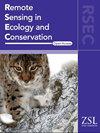Consistent and scalable monitoring of birds and habitats along a coffee production intensity gradient
IF 4.3
2区 环境科学与生态学
Q1 ECOLOGY
引用次数: 0
Abstract
Land use change associated with agricultural intensification is a leading driver of biodiversity loss in the tropics. To evaluate the habitat–biodiversity relationship in production systems of tropical agricultural commodities, birds are commonly used as indicators. However, a consistent and reliable methodological approach for monitoring tropical avian communities and habitat quality in a way that is scalable is largely lacking. In this study, we examined whether the automated analysis of audio data collected by passive acoustic monitoring, together with the analysis of remote sensing data, can be used to efficiently monitor avian biodiversity along the gradient of habitat degradation associated with the intensification of coffee production. Coffee is an important crop produced in tropical forested regions, whose production is expanding and intensifying, and coffee production systems form a gradient of ecological complexity ranging from forest‐like shaded polyculture to dense sun‐exposed monoculture. We used LiDAR technology to survey the habitat, together with autonomous recording units and a vocalization classifier to assess bird community composition in a coffee landscape comprising a shade‐grown coffee farm, a sun coffee farm and a forest remnant, located in southern Mexico. We found that LiDAR can capture relevant variation in vegetation across the habitat gradient in coffee systems, specifically matching the generally observed pattern that the intensification of coffee production is associated with a decrease in vegetation density and complexity. We also found that bioacoustics can capture known functional signatures of avian communities across this habitat degradation gradient. Thus, we show that these technologies can be used in a robust way to monitor how biodiversity responds to land use intensification in the tropics. A major advantage of this approach is that it has the potential to be deployed cost‐effectively at large scales to help design and certify biodiversity‐friendly productive landscapes.沿着咖啡生产强度梯度对鸟类和栖息地进行一致和可扩展的监测
与农业集约化相关的土地利用变化是热带地区生物多样性丧失的主要驱动因素。为了评价热带农产品生产系统中生境与生物多样性的关系,鸟类通常被用作指标。然而,目前在很大程度上缺乏一种可扩展的监测热带鸟类群落和栖息地质量的一致和可靠的方法学方法。在这项研究中,我们研究了被动声学监测音频数据的自动分析与遥感数据分析是否可以有效地监测与咖啡生产集约化相关的栖息地退化梯度上的鸟类生物多样性。咖啡是热带森林地区的一种重要作物,其产量正在扩大和强化,咖啡生产系统形成了一个生态复杂性的梯度,从森林般的遮荫复合栽培到密集的阳光照射单一栽培。我们使用激光雷达技术来调查栖息地,连同自主记录单元和发声分类器来评估位于墨西哥南部的咖啡景观中的鸟类群落组成,该景观包括遮荫咖啡农场、阳光咖啡农场和森林遗迹。我们发现,激光雷达可以捕捉到咖啡系统中不同生境梯度下植被的相关变化,特别是与普遍观察到的模式相匹配,即咖啡产量的增加与植被密度和复杂性的降低有关。我们还发现,生物声学可以捕捉到鸟类群落在这种栖息地退化梯度中的已知功能特征。因此,我们表明,这些技术可以以一种稳健的方式用于监测生物多样性如何响应热带地区的土地利用集约化。这种方法的一个主要优点是,它有可能在大规模的成本有效的部署,以帮助设计和认证生物多样性友好的生产性景观。
本文章由计算机程序翻译,如有差异,请以英文原文为准。
求助全文
约1分钟内获得全文
求助全文
来源期刊

Remote Sensing in Ecology and Conservation
Earth and Planetary Sciences-Computers in Earth Sciences
CiteScore
9.80
自引率
5.50%
发文量
69
审稿时长
18 weeks
期刊介绍:
emote Sensing in Ecology and Conservation provides a forum for rapid, peer-reviewed publication of novel, multidisciplinary research at the interface between remote sensing science and ecology and conservation. The journal prioritizes findings that advance the scientific basis of ecology and conservation, promoting the development of remote-sensing based methods relevant to the management of land use and biological systems at all levels, from populations and species to ecosystems and biomes. The journal defines remote sensing in its broadest sense, including data acquisition by hand-held and fixed ground-based sensors, such as camera traps and acoustic recorders, and sensors on airplanes and satellites. The intended journal’s audience includes ecologists, conservation scientists, policy makers, managers of terrestrial and aquatic systems, remote sensing scientists, and students.
Remote Sensing in Ecology and Conservation is a fully open access journal from Wiley and the Zoological Society of London. Remote sensing has enormous potential as to provide information on the state of, and pressures on, biological diversity and ecosystem services, at multiple spatial and temporal scales. This new publication provides a forum for multidisciplinary research in remote sensing science, ecological research and conservation science.
 求助内容:
求助内容: 应助结果提醒方式:
应助结果提醒方式:


